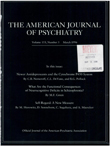The prevalence and distribution of major depression in a national community sample: the National Comorbidity Survey
Abstract
OBJECTIVE: Major depression is a frequent and disabling psychiatric disorder in the United States. This report examines the prevalence and risk factor profile of both pure and comorbid major depression according to data from the National Comorbidity Survey. METHOD: To estimate the prevalence of psychiatric comorbidity in the United States, a national sample of 8,098 persons 15-54 years of age from the 48 conterminous states was surveyed with a modified version of the Composite International Diagnostic Interview. Results: From the survey data the prevalence of current (30-day) major depression was estimated to be 4.9%, with a relatively higher prevalence in females, young adults, and persons with less than a college education. The prevalence estimate for lifetime major depression was 17.1%, with a similar demographic distribution. Both 30-day and lifetime prevalence estimates were higher than estimates from the earlier Epidemiologic Catchment Area study. When pure major depression was compared with major depression co-occurring with other psychiatric disorders, the risk factor profiles exhibited clear differences. CONCLUSIONS: These findings suggest a greater burden of major depression in community- dwelling persons than has been estimated from previous community samples. The risk factor profile showed significant differences between persons with pure and combined major depression.
Access content
To read the fulltext, please use one of the options below to sign in or purchase access.- Personal login
- Institutional Login
- Sign in via OpenAthens
- Register for access
-
Please login/register if you wish to pair your device and check access availability.
Not a subscriber?
PsychiatryOnline subscription options offer access to the DSM-5 library, books, journals, CME, and patient resources. This all-in-one virtual library provides psychiatrists and mental health professionals with key resources for diagnosis, treatment, research, and professional development.
Need more help? PsychiatryOnline Customer Service may be reached by emailing [email protected] or by calling 800-368-5777 (in the U.S.) or 703-907-7322 (outside the U.S.).



